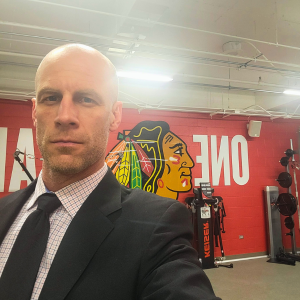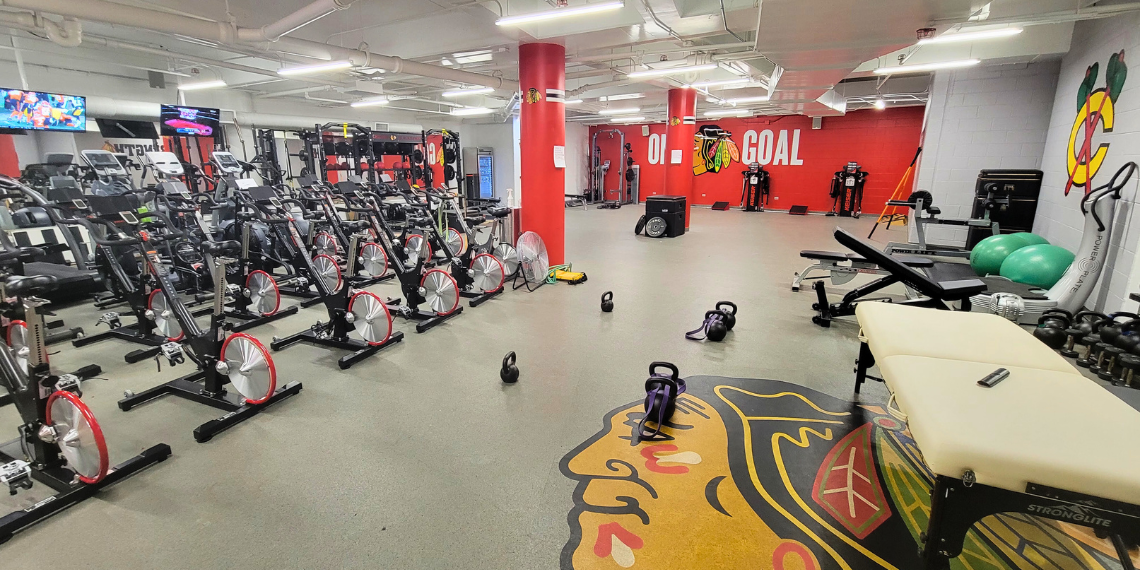Sports science researcher Dr. Jamie Burr takes role leading Chicago Blackhawks’ training and performance program
 Dr. Jamie Burr, associate professor in the Department of Human Health and Nutritional Sciences, is bringing his background in health and performance research, as well as his years of experience working as an exercise physiologist with professional and elite athletes, to the NHL’s Chicago Blackhawks. For the next three years, Burr will be the Blackhawks’ High Performance Advisor, tasked with taking the team’s training and performance regimen to the next level, while continuing his research at the University of Guelph.
Dr. Jamie Burr, associate professor in the Department of Human Health and Nutritional Sciences, is bringing his background in health and performance research, as well as his years of experience working as an exercise physiologist with professional and elite athletes, to the NHL’s Chicago Blackhawks. For the next three years, Burr will be the Blackhawks’ High Performance Advisor, tasked with taking the team’s training and performance regimen to the next level, while continuing his research at the University of Guelph.
Starting this past spring, he has helped the team refine the way they approach human performance, which encompasses everything from physical fitness testing, strength and conditioning, sports nutrition, and recovery. He works closely with the Blackhawks’ Hockey Strategy and Analytics team, who use data and analytics to identify patterns, make predictions and inform a variety of decisions, affecting what happens both on and off the ice for physical conditioning and recovery.
“I think we’re seeing a revolution in hockey to embrace sports science in ways that haven’t been done in the past,” says Burr. “It wasn’t that long ago where players didn’t show up to camp in shape. These days, every player that makes the NHL is good. I think now as we get to the pointy end, teams that want to be competitive realize they need every advantage they can get.”
Burr’s role is one of only a handful in professional hockey, but similar roles, especially those that incorporate data and analytics, have been part of professional baseball and football for many years. The Blackhawks’ team of data scientists analyze a wide variety of data, including from wearable gadgets and in-game tracking. From that data, advisors and trainers can make more informed decisions to optimize players’ performance on and off the ice.
Besides identifying areas where team staff can help players improve fitness or hone their craft, Burr can also use the data to identify when players are pushing too hard, so they can adjust training, recovery, or rest. His group is also ensuring the team stays on top of the latest advancements in nutrition and sleep science, as tight schedules and travel, often across time zones, can have an impact on players’ wellbeing and performance.

Burr has also worked with NHL draft data to identify talent among young players and hopes to help the Blackhawks in this way as well. The topic is one he has been studying since he was a graduate student, when he authored an article looking at the relationship between the players’ performance in physical fitness tests, such as jumps and bench presses, and their potential on the ice. With recent high-profile draft picks, such as phenom Connor Bedard, and a number of high draft picks in the coming years, this will be an important part of the Blackhawks rebuild. He also regularly works with the Blackhawks’ development staff and farm team, the AHL’s Rockford IceHogs, to identify talent and coach players to reach their full potential.
While Burr’s work with the Blackhawks means he is taking a break from teaching at the U of G, he continues to supervise the work of graduate students in the Human Performance and Health Research Lab. He is spending about half his time in Guelph and half his time with the Blackhawks, though he is looking for more ways to bridge the two worlds.
“I love what I do at the university,” he says. “It’s always exciting when you can ask and answer questions that you care about. Now working with Chicago, it's really neat to see the concepts that we've been thinking about applied in the real world. It’s nice to see our work move the needle.”
He has been able to incorporate some of the exercises his team has studied in the Human Performance and Health Research lab into the Blackhawks’ training regimen. He’s also been able to bring some of his graduate students and a postdoctoral fellow with him to do hydration testing on the team, with support from Human Health and Nutritional Sciences Professor Emeritus Lawrence Spriet, in order to create a customized hydration plan for each player.
Burr plans to incorporate more applied sports science into his role with the Blackhawks in the future and hopes to hire someone to keep tabs on new findings in sports science research and look for practical uses for the team.
When he returns to teaching at the university, Burr can incorporate his experiences into his teaching too, since he’ll be able to demonstrate concepts with practical examples.
“This type of ‘real-world’ experience always enhances the stories I can tell and connections I can make with students when I get back in the classroom. I love watching students light up when they realize how the theoretical concepts introduced in lecture and lab are the very same things we use to inform the decisions we make with some of the best athletes in the world.”